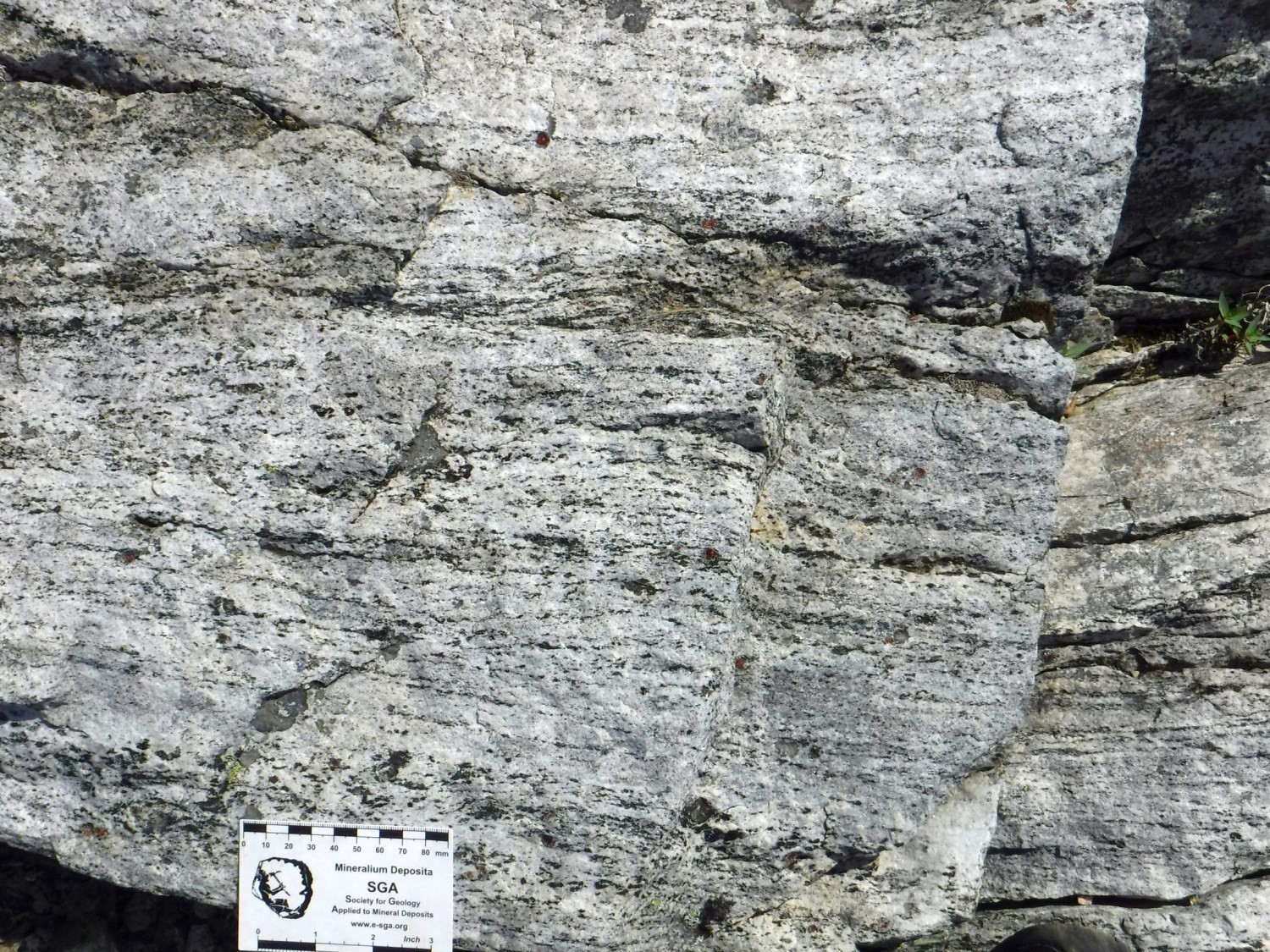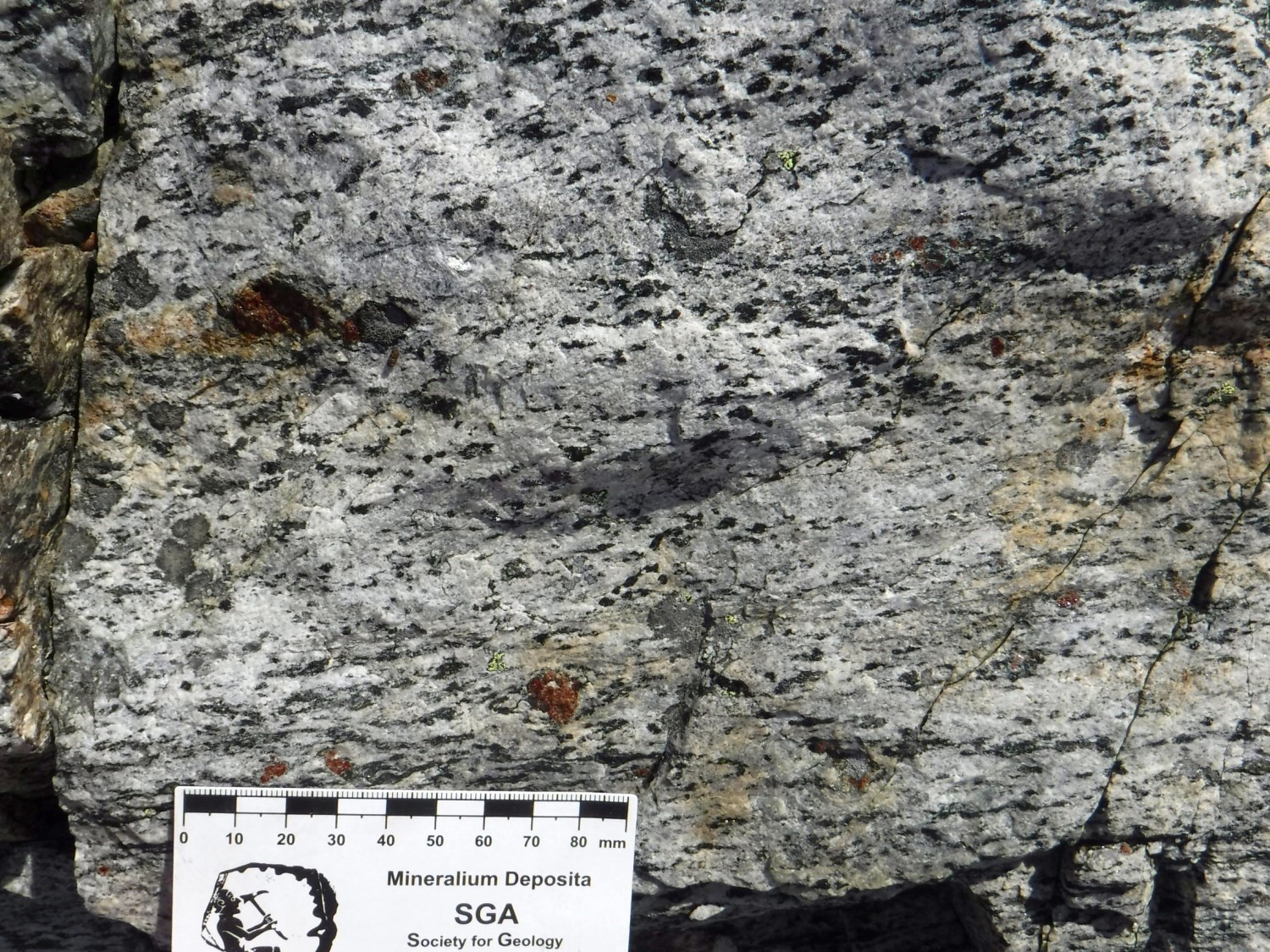
Last modified: 31 October 2023
DISCLAIMER: This English version is translated from the original French. In case of any discrepancy, the French version shall prevail.
| Author(s): | Wardle et al., 1993 |
| Age: | Archean; Paleoproterozoic |
| Stratotype: | None |
| Type area: | Grenfell Sound area (NTS sheet 25A) |
| Geological province: | Nain Province |
| Geological subdivision: | Burwell Lithotectonic Domain |
| Lithology: | Metamorphosed mafic intrusive rocks |
| Category: | Lithodemic |
| Rank: | Suite |
| Status: | Formal |
| Use: | Acive |
None
Background
Taylor (1979) initially reported the presence of gneissic anorthositic lenses on the western margin of Archean gneiss of the Nain Province. Van Kranendonk and Wardle (1996) map the suite for almost 400 km long over most of its extent (except Circle Mountain area, NTS sheets 14L12 and 14L13). In 1993, Wardle et al. introduced the term Hutton Suite, based on the namesake peninsula in the Home Island area (sheet 25A01), in Labrador. According to them, this suite is assigned to the Nain Province because it is located right in the Komaktorvik Shear Zone. However, the absence of an emplacement age and its location on the boundary of the Burwell Lithotectonic Domain and the Nain Province makes it equivocal. Verpaelst et al. (2000) introduced the name Iberville Complex to group anorthositic gneiss and granulitic gneiss outcropping on the east side of the Tasiuyak Complex in the Circle Mountain area (sheets 14L13 and 14L12). Mathieu et al. (2018) report anorthosite and norite strips in the same area, but stick to the old name for the mafic phase, the orthopyroxene felsic phases being attached to the Killinek Suite.
Description
Ermanovics and Van Kranendonk (1998) report a unit consisting primarily of anorthosite, but also gabbroic anorthosite, diorite, and minor amounts of amphibolite and tectonic klippes of ultramafic lenses in contact between the Nain and Churchill provinces. Anorthositic lithologies are described as white, coarse-grained, foliated to gneissic and locally stratified. Van Kranendonk and Wardle (1996) describe an anorthosite whose appearance changes from coarse-grained and subophitic with labradorite bluish crystals in its eastern part, to medium-grained and white granoblastic gneiss in the western part near the granulite isograd. They also observe primary magmatic bedding preserved in the least deformed zones, with local anhedral hyperstene crystals 60 cm in diameter. According to these authors, the anorthositic gabbro facies dominates.
Verpaelst et al. (2000) and Mathieu et al. (2018) map hectometric strips of anorthosite interbedded with granulitic gneiss near Mont-Iberville, therefore in the area most heavily deformed. The patina and fresh surface have a white colour characteristic of the recrystallization of plagioclase. Samples may also be beige in altered surface and olive-coloured in fresh exposure. The general appearance is banded and described as gneissic (Verpaelst et al., 2000), protomylonitic (Mathieu et al., 2018) to mylonitic, but the igneous texture is still visible. Centimetric to metric compositional banding is defined by the variation in the proportion of in-line mafic minerals.
Hutton Suite 1 (ApPhut1): Orthopyroxene-Clinopyroxene-Hornblende Anorthosite
Unit composed of anorthosite, quartz anorthosite and leuconorite, all of which are highly magnetic. These lithologies alternate in centimetric to metric bands and have the same petrographic characteristics. The proportion of mafic minerals ranges from 5 to 25%, quartz from 0 to 10%. Plagioclase forms large centimetric, fine to medium-grained partially recrystallized zones with deformed twins and undulatory extinction. It is slightly sericitized. The main mafic phases are green hornblende and orthopyroxene. They are grouped in discontinuous laminae and stretched globular clusters (in line) of millimetre size. Overall, green hornblende develops along the edge of the clusters and orthopyroxene is in the core. The latter is partially replaced by iddingsite, carbonates and oxides, while hornblende is rimmed by clinopyroxene-plagioclase symplectite. Brown-red biotite is locally observed on the margins of clusters. It is generally skeletal. Quartz is recrystallized into spectacular rods with a ratio of locally 8:1, composed of anhedral crystals with undulatory extinction. Accessory phases are opaque minerals, apatite, zircon, sphene, clinopyroxene, iddingsite, carbonates, green spinel (hercynite?) and garnet. Garnet is poikiloblastic with quartz or untwinned plagioclase symplectite.
Hutton Suite 2 (ApPhut2): Garnet Norite, Garnetite and Olivine Websterite
This unit was introduced to distinguish strips that were richer in mafic minerals (>50%). It consists of rocks of similar appearance, dominated by a garnet norite and incorporating minor amounts of garnetite and olivine websterite.
Norite is mesococratic to melanoratic. It is dark green in both patina and fresh exposure. It is highly magnetic. Mafic minerals are dominated by orthopyroxene. Garnet is poikiloblastic with granoblastic plagioclase decompression rim. Plagioclase-pyroxene symlectite rimming amphiboles is also observed. Orthopyroxene is serpentinized, partially replaced by iddingsite. Green hornblende is the dominant mafic phase, it is slightly corroded and defines foliation. The matrix is composed of granoblastic plagioclase (<20%), orthopyroxene and clinopyroxene (<5%). Accessory phases are opaque minerals (magnetite) and apatite.
Metric ultramafic boudins of olivine websterite were observed locally. The rock is composed of lepidoblastic actinolite (50%) and granoblastic orthopyroxene crystals, olivine (15%) and opaque minerals. Metric to decametric strips of garnetite were observed. Garnetite is also found as boudins in anorthosite. Garnet forms 2 to 5 mm poikiloblasts with numerous inclusions of pyroxene, quartz and apatite. It is accompanied by a plagioclase rim, involving rapid decompression during retrograde metamorphism.
Thickness and Distribution
The Hutton Suite was recognized for at least 350 km (Wardle et al., 1992, 1993) in a N-S strip extending from west of Okak Bay (North River region, sheet 14L) to Killiniq Island (sheet 25A07). The main body is 110 km long and 3 km wide (Van Kranendonk and Wardle, 1996).
Dating
Taylor (1979) assumes a Paleoprotezoic age, while Wardle et al. (1993) prefer an Archean origin and highlight its atypical appearance which differs greatly from Archean anorthosites of the Nain Province. They rely on the abundance of anorthosite in the Nain Province and its relative rarity in the Churchill Province. They also rely on the presence of trondhjemitic mobilisate (Ryan et al., 1991) similar to that of Archean gneiss of the Nain Province cutting the anorthosite. However, this mobilisate may also be the result of a later metamorphic episode, such as the one affecting the Burwell Lithotectonic Domain (ultrametamorphic granite dated 1843 Ma, Bertrand et al., 1993). The question remains open.
Dating has defined an age of emplacement for anorthosite that predates 1804 Ma and a metamorphic age at 1781 Ma (Scott and Machado, 1995) from three samples taken in the Hutton Peninsula (Home Island area, sheet 25A01). An intrusion of pink granite cutting anorthosite reported an age interpreted as crystallization at 1804 ±3 Ma with the U-Pb method on a single zircon, as well as a concordant age on monazite at 1793 ±3 Ma. Tonalitic intrusions considered as melting products of the host gneiss give a crystallization age of 1781 ±3 Ma on a single zircon with the U-Pb method. The U-Pb analysis on scarce zircons of the anorthosite sample gives two concordant ages, similar to the crystallization age of the partial melting liquid at 1781 ±2 Ma and 1780 ±3 Ma. The age of 1781 Ma is interpreted as the episode of metamorphism to the amphibolite facies that generated the trondhjemitic fluid.
Stratigraphic Relationship(s)
The Hutton Suite is interbedded between the Noodleook Complex gneisses, the Killinek Suite orthopyroxene intrusions and the Tasiuyak Complex diatexites. Ermanovics and Van Kranendonk (1998) propose tectonic contact, linked to the Torngat orogenesis, between the Hutton Suite in the form of slices and surrounding rocks of the Churchill Province, assuming that the suite belongs to the Nain Province. Van Kranendonk and Wardle (1996) rather assume intrusion as sills; they report sharp contact with the surrounding gneiss. Contacts with other units were not observed during the summer mapping campaigns of 1998 (Verpaelst et al., 2000) and 2017 (Mathieu et al., 2018).
Paleontology
Does not apply.
References
Publications available through SIGÉOM Examine
MATHIEU, G., LAFRANCE, I., VANIER, M.-A., 2018. Géologie de la région de pointe Le Droit, Province de Nain et sud-est de la Province de Churchill, Nunavik, Québec, Canada. MERN; BG 2018-07, 4 plans.
VERPAELST, P., BRISEBOIS, D., PERREAULT, S., SHARMA, K. N. M., DAVID, J., 2000. Géologie de la région de la rivière Koroc et d’une partie de la région de Hébron, 24I et 14L. MRN; RG 99-08, 62 pages, 10 plans.
Other publications
BERTRAND, J.M., RODDICK, J.C., KRANENDONK, M.J., ERMANOVICS, I. 1993. U-Pb geochronology of deformation and metamorphism across a central transect of the Early Proterozoic Torngat Orogen, North River map area, Labrador. Revue canadienne des sciences de la Terre, volume 30 (7): pages 1470-1489. https://doi.org/10.1139/e93-127
ERMANOVICS, I., VAN KRANENDONK, M.J. 1998. Geology of the Archean Nain Province and Paleoproterozoic Torngat Orogen in a transect of the North River-Nutak map areas, Newfoundland (Labrador) and Quebec. Commission géologique du Canada, Bulletin 497, 156 pages, 7 plans. https://doi.org/10.4095/209574
RYAN, B., KROGH, T.H., HEAMAN, L., SCHÄRER, U, PHILIPPE, S., OLIVER, G. 1991. On recent geochronological studies in the Nain Province, Churchill Province and Nain Plutonic Suite, north-central Labrador. In: Current Research, Newfoundland Department of Mines and energy, Mineral Development Division; Report 91-1, pages 257 à 262. https://www.gov.nl.ca/iet/files/mines-geoscience-publications-currentresearch-1991-ryan-compiler.pdf
SCOTT, D.J., MACHADO, N. 1995. U-Pb geochronology of the northern Torngat Orogen, Labrador, Canada: a record of Palaeoproterozoic magmatism and deformation. Precambrian Research, Volume 70, Issues 3-4, pages 169-190. https://doi.org/10.1016/0301-9268(94)00038-S
TAYLOR, F.C. 1979. Reconnaissance geology of a part of the Precambrian Shield, northeastern Quebec, northern Labrador and northwest Territories. Geological Survey of Canada; Memoir 393, 99 pages and 19 maps. https://doi.org/10.4095/124930
VAN KRANENDONK, M.J., WARDLE, R.J. 1996. Burwell domain of the Palaeoproterozoic Torngat Orogen, northeastern Canada: Tilted cross-section of a magmatic arc caught between a rock and a hard place; In: Geological Society London Special Publications 112(1): pages 91-115.
https://doi.org/10.1144/gsl.sp.1996.112.01.06
VAN KRANENDONK, M.J., WARDLE, R.J., MENGEL, F.C., SCOTT, D.J. 1992. Geological mapping in the Torngat Orogen, northernmost Labrador: preliminary results. In: Current Research, Newfoundland Department of Mines and energy, Mineral Development Division; Report 92-1, pages 413-430. https://www.gov.nl.ca/iet/files/mines-geoscience-publications-currentresearch-1992-wardle.pdf
WARDLE, R.J., VAN KRANENDONK, M.J., MENGEL, F.C., SCOTT, D.J., SCHWARZ, S., RYAN, B., BRIDGWATER, D. 1993. Geological mapping in the Torngat Orogen. Northernmost Labrador: Report 2. In: Current Research, Newfoundland Department of Mines and Energy, Geological Survey Branch, Report 93-1, pages 77-89. https://www.gov.nl.ca/iet/files/mines-geoscience-publications-currentresearch-1993-wardle.pdf
Suggested Citation
Ministère des Ressources naturelles et des Forêts (MRNF). Hutton Suite. Quebec Stratigraphic Lexicon. https://gq.mines.gouv.qc.ca/lexique-stratigraphique/province-de-nain/suite-hutton_en [accessed on Day Month Year].
Contributors
|
First publication |
Guillaume Mathieu, Geology Engineer, M. Sc. guillaume.mathieu@mrnf.gouv.qc.ca (redaction) Mehdi A. Guemache, P. Geo., Ph. D. (coordination); Simon Auclair, P. Geo., M. Sc. (critical review and editing); Céline Dupuis, P. Geo., Ph. D. (English version); André Tremblay and Nathalie Bouchard (HTML editing). |



